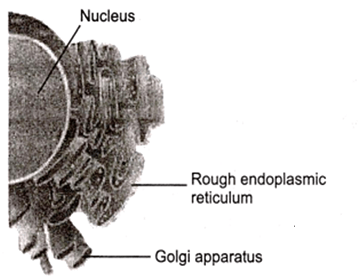 Multiple Choice Questions
Multiple Choice QuestionsWhich of the following is not correctly matched for the organism and its cell wall degrading enzyme?
Bacteria - Lysozyme
Plant cells - Cellulase
Algae - Methylase
Fungi - Chitinase
The Golgi complex plays a major role
in trapping the light and transforming it into chemical energy
in digesting proteins and carbohydrates
as energy transferring organelles
in post translational modification of proteins and glycosidation of lipids
Which one of the following organelle in the figure correctly matches with its function?

Rough endoplasmic reticulum, formation of glycoproteins
Golgi apparatus, protein synthesis
Golgi apparatus, formation of glycolipids
Rough endoplasmic reticulum, protein synthesis
Which of the following is always absent in prokaryotic cells?
Ribosome
Mitochondria
DNA
Cell wall
Objects less than 0.2 m in size cannot be see an under light microscope because
the wave length of visible light is 3900- 7800 Å
only two types of lenses are used
maximum magnifying power of ocular lens is 20 X
maximum magnifying power of objective lens is 100 X
A.
the wave length of visible light is 3900- 7800 Å
Light microscopy employs visible light to detect small objects. It has the ability to magnify an object upto 1000 times. High quality light microscopes generally allow viewing of bacterial cells too. The light microscope cannot view viruses or other tiny objects about or less than 0.2 µm because it does not allow to view objects smaller than the wavelength of visible light (3900-7800 Å). Thus, to view extremely small or tiny object scientist preffered to use electron microscopy.
The apoplast is located
outside the plasma membrane
in the entire cytosol
on both sides of plasma membrane
in the plastidial content
ATP synthesis in cell requires
H+ gradient across the membrane
K+ gradient across the membrane
PO4 3- gradient across the membrane
Ca2+ gradient across the membrane
The eukaryotic cells have all of the followings except
peptidoglycan in the cell wall
the 80 S ribosome
nuclear membrane
mitochondria
